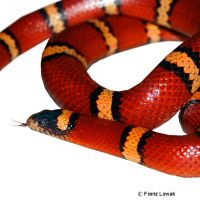Mexican Milksnake (Lampropeltis annulata)
| Mexican Milksnake Lampropeltis annulata | |
|---|---|
| Name | Mexican Milksnake |
| Name Lat. | Lampropeltis annulata |
| Synonym | Lampropeltis triangulum annulata |
| Family | Colubrids |
| Family lat. | Colubridae |
| Order | Scaled Reptiles |
| Order lat. | Squamata |
| Origin | SW-USA, Mexico |
| Habitat | Humid forests |
| Diet | Rodents |
| Humidity | 50-70 % |
| Behavior | Nocturnal |
| Keeping | Individual |
| Care Level | Moderate |
| Reproduction | Oviparous |
| Housing | Semi-humid terrarium |
| Life Span | 10-15 years |
| Protection | No |
| Metric Units | |
| Size | 60-80 cm |
| Temperature | 24-28 °C |
| Temperature Local | 30-33 °C |
| Housing Size | 100 x 50 x 50 cm |
| US Units | |
| Size | 24"-31" |
| Temperature | 75-82 °F |
| Temperature Local | 86-91 °F |
| Housing Size | 40" x 20" x 20" |
Distribution and habitat
The crepuscular and nocturnal, ground-dwelling Mexican Milk Snake is native to the southwestern United States and Mexico, in moist forests and grasslands. During the day, they usually hunker down under rocks and logs.
Maintenance
Minimum dimensions for the terrarium, according to the size and number of animals:
| 1-2 animals | 1KL x 0,5KL x 0,5KL (L x W x H) |
Body length (KL) is measured on the largest animal. For each additional animal the floor space should be increased by 20%. A terrarium of e.g. L 100 x W 50 x H 50 cm is recommended, which should be placed in a quiet and vibration-free place.
They need a terrarium structured with roots, stones and cork tubes (hiding places and visual protection) with a graveable substrate, e.g. of sand-humus mixture with peat and foliage, as well as an easy-to-clean water basin as drinking vessel. To ensure constant humidity, a small portion of the substrate must always be kept slightly moist, for which sheets of sphagnum moss are well suited. Once a day, preferably in the evening, the inside of the terrarium should be finely sprayed with water. A rain or mist system is ideal
| Temp. day: 24-28 °C | Temp. night: 20-22 °C | Temp. local: up to 33 °C | Humidity: 50-70 |
Thermostatically controlled floor heating is recommended. Lighting duration must be 12-14 hrs depending on the season. Daylight fluorescent tubes supplemented with spotlights are ideal.
Diet
The food supply consists of live small lizards and rodents (e.g. mice) as well as nest young chicks according to their size. After successful acclimation, the changeover to dead food animals (commercial frozen food) is often successful. Juveniles should be offered food every 3-5 days, adults every 7-14 days, with occasional periods of fasting (e.g., skipping a feeding). If the snake is disturbed after feeding, this may result in vomiting of the prey. It is better to offer several small feeders, rather than one large one. If it does not eat for a long period of time, both the timing and the food should be varied. It is important to fortify the food animals with vitamins and minerals. Since the snake could be injured by live rodents, it should not be left unattended with them.
Reproduction and breeding
Probing by the veterinarian is the only reliable method of sex determination.
A short resting period is recommended for successful reproduction. The female likes to lay her eggs (2-16 of them) in rotten tree trunks, using the heat generated by rotting to offset nighttime temperatures. She does not engage in brood care. The incubation period is 60-70 days at a temperature of 28 °C
Important
Socialization is not recommended, as they eat conspecifics and other snakes, including venomous ones. When threatened, they may emit strong-smelling feces. They often mimic the coloration of venomous snakes in an attempt to deceive their hunters (mimicry)
A resting period of 3-4 months at a temperature of 10-15 °C accompanied by a feeding break is recommended.
Always have snake hooks and protective gloves ready when handling.
The terrarium must have good ventilation without drafts and meet the species-specific needs. Measuring devices such as thermometers, hygrometers, etc. are necessary. The lighting has to correspond to the species-specific day-night rhythm and has to be placed in such a way that the animals cannot injure themselves. The terrarium should be locked in such a way that neither unauthorized persons can open it nor the animals can escape. Contamination must be removed regularly
Further literature can be found in your pet store.
References
Text: petdata; Image: Franz Lowak
Source: BMELV (1997): Tierschutzgutachten - Mindestanforderungen an die Haltung von Reptilien; ENGELMANN (2006): Zootierhaltung - Tiere in menschlicher Obhut: Reptilien und Amphibien, Harri Deutsch Verlag
- Gemäß § 21 Abs. 5 Tierschutzgesetz idgF
